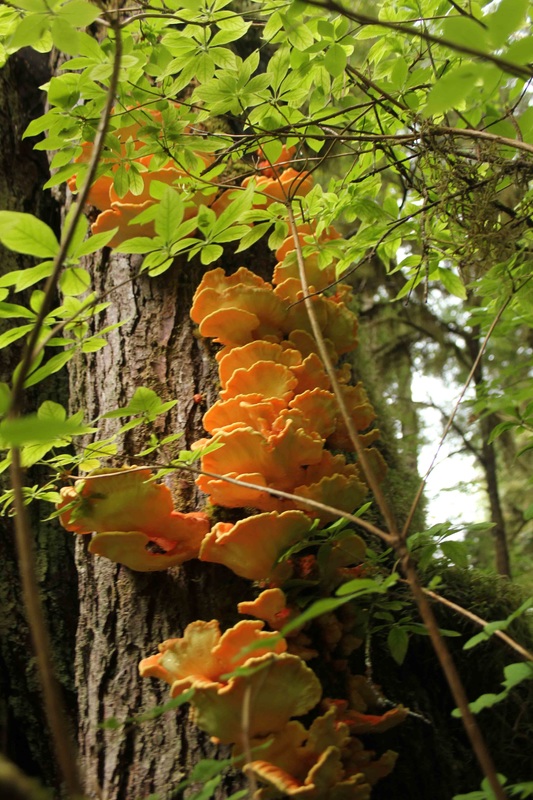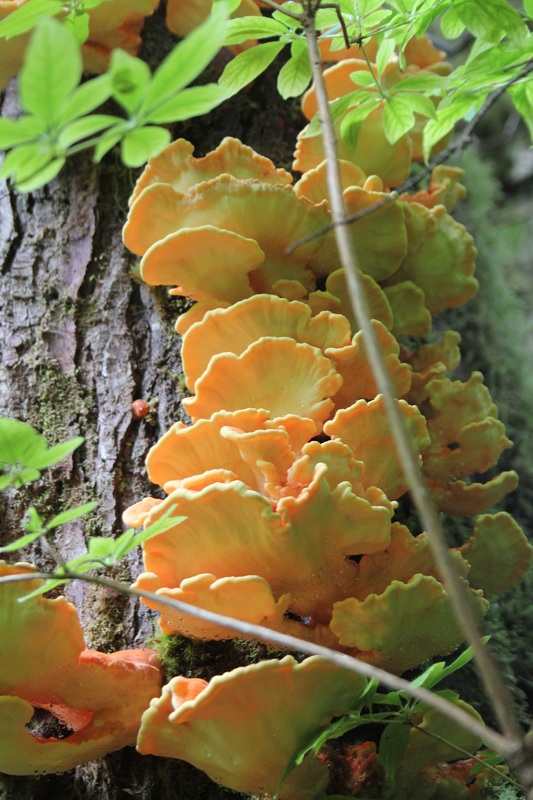Chicken Mushroom • Laetiporus conifericola
Identification
This common and conspicuous shelf-like fungus typically grows singly, or in overlapping clusters. The caps (tops) range in colour from orange-red to orange-yellow, while the porous underside is typically sulfur yellow. The caps are typically 5-50 cm wide and up to 4 cm thick. Stems are either absent, or are only differentiated by the slight narrowing at the base of the fruiting body. This species is an annual, and when it emerges from its substrate in the fall, its knob or finger-like form soon grows into its characteristic fan-like to semi-circular shape after about four weeks. The surface of the fungus is uneven or sometimes wrinkly, initially quite soft and tender when young, and becomes pale, tough and crumbly with age.
Habitat and Range
Chicken mushroom is a widespread and common species in the Pacific Northwest from Alaska south to California, and grows on a variety of mature conifers as well as on dead stumps and logs. It can grow singularly, but is more often found growing in clusters.
Similar Species
Another species of Laetiporus found in the Pacific Northwest is L. gilbertsonii. However, L. gilbertsonii grows primarily on hardwoods such as Quercus (oak) and Eucalyptus spp. It is found near the Mexican border and in close proximity to the Pacific Ocean north to Washington State, and is not found on the BC’s Central Coast. Chicken mushroom was formerly identified as L. sulphureus, however, recent genetic analyses have suggested that "true" L. sulphureus is not found west of the Rocky Mountains.
Human Uses
The common name of this species is inspired by the distinct chicken-like flavour of the tender margins when properly cooked. Though this species is edible, it becomes increasingly inedible and unpalatable as it ages, and should not be eaten raw. Poisoning and allergic reactions, such as swollen lips, is known to occur from this species, so always be certain and confident in your identification before consumption. By only trimming the tender margin when harvesting, you may be able to return for more as the margin continues to grow.
This common and conspicuous shelf-like fungus typically grows singly, or in overlapping clusters. The caps (tops) range in colour from orange-red to orange-yellow, while the porous underside is typically sulfur yellow. The caps are typically 5-50 cm wide and up to 4 cm thick. Stems are either absent, or are only differentiated by the slight narrowing at the base of the fruiting body. This species is an annual, and when it emerges from its substrate in the fall, its knob or finger-like form soon grows into its characteristic fan-like to semi-circular shape after about four weeks. The surface of the fungus is uneven or sometimes wrinkly, initially quite soft and tender when young, and becomes pale, tough and crumbly with age.
Habitat and Range
Chicken mushroom is a widespread and common species in the Pacific Northwest from Alaska south to California, and grows on a variety of mature conifers as well as on dead stumps and logs. It can grow singularly, but is more often found growing in clusters.
Similar Species
Another species of Laetiporus found in the Pacific Northwest is L. gilbertsonii. However, L. gilbertsonii grows primarily on hardwoods such as Quercus (oak) and Eucalyptus spp. It is found near the Mexican border and in close proximity to the Pacific Ocean north to Washington State, and is not found on the BC’s Central Coast. Chicken mushroom was formerly identified as L. sulphureus, however, recent genetic analyses have suggested that "true" L. sulphureus is not found west of the Rocky Mountains.
Human Uses
The common name of this species is inspired by the distinct chicken-like flavour of the tender margins when properly cooked. Though this species is edible, it becomes increasingly inedible and unpalatable as it ages, and should not be eaten raw. Poisoning and allergic reactions, such as swollen lips, is known to occur from this species, so always be certain and confident in your identification before consumption. By only trimming the tender margin when harvesting, you may be able to return for more as the margin continues to grow.
References
Arora, David. Mushrooms demystified. Ten Speed Press, 1986.Pp. 572-573.
Burdsall Jr, Harold H., and Mark T. Banik. "The genus Laetiporus in North America." Harvard Papers in Botany (2001): 43-55.
Laetiporus conifercola. In Klinkenberg, Brian. (Ed.). E-Flora BC: Electronic Atlas of the Plants of British Columbia. Lab for Advanced Spatial Analysis, Department of Geography, University of British Columbia, Vancouver. Accessed 2016-02-29
Lincoff, Gary H. The audubon society field guide to North American mushrooms. No. 635.8 L5. 1989. Pp. 468-469.
Lindner, Daniel L., and Mark T. Banik. "Molecular phylogeny of Laetiporus and other brown rot polypore genera in North America." Mycologia 100.3 (2008): 417-430.
Authors and editors of page
Bea Proudfoot and Kelly Fretwell (2016)
Arora, David. Mushrooms demystified. Ten Speed Press, 1986.Pp. 572-573.
Burdsall Jr, Harold H., and Mark T. Banik. "The genus Laetiporus in North America." Harvard Papers in Botany (2001): 43-55.
Laetiporus conifercola. In Klinkenberg, Brian. (Ed.). E-Flora BC: Electronic Atlas of the Plants of British Columbia. Lab for Advanced Spatial Analysis, Department of Geography, University of British Columbia, Vancouver. Accessed 2016-02-29
Lincoff, Gary H. The audubon society field guide to North American mushrooms. No. 635.8 L5. 1989. Pp. 468-469.
Lindner, Daniel L., and Mark T. Banik. "Molecular phylogeny of Laetiporus and other brown rot polypore genera in North America." Mycologia 100.3 (2008): 417-430.
Authors and editors of page
Bea Proudfoot and Kelly Fretwell (2016)





